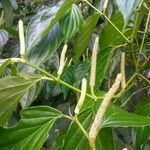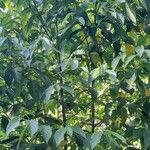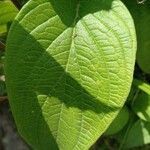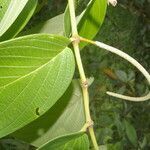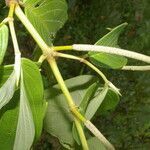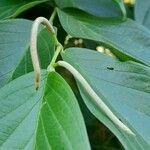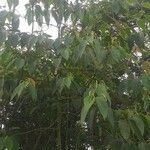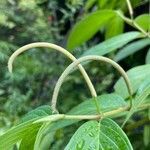Shrub or treelet, 3-7 m tall. Stem sparsely pubescent to glabrescent; upper internodes rather slender. Prophyll to 2.5 cm long, pubescent at least on primary vein. Leaves somewhat glandular-dotted; petiole 0.3-0.8 cm long, pubescent, vaginate near base; blade scabrous, yellow-green, lanceolate or lanceolate-oblong or elliptic-ovate, 12-24 x 3-8 cm, apex acuminate, base unequally attached to petiole 0.3-0.4 cm, rounded to subcordate, sparsely pubescent at least on veins above or glabrescent, sparsely pubescent or glabrescent below, somewhat rugulose; pinnately veined, secondary veins 6-8 per side, arising from 1/2 to 3/4 of primary vein, sharply ascending, impressed above, prominent below, tertiary veins parallel between secondaries, minor veins reticulate. Inflorescence recurved; peduncle 0.7-1.2(-2.5) cm long, sparsely pubescent; spike 8-15 cm long, white to green, apiculate; flowers densely arranged in rings or spirals; floral bracts densely marginally fringed; stamens with broad connective. Infructescence recurved; fruits obovoid, trigonous or somewhat tetragonous, 0.7-0.8 mm in diam., glabrous or glabrescent, glandular, stigmas 3, sessile.
An erect shrub 2–5 m high (can develop into a small tree to 7 m high and have stilt roots); bisexual. Nodes swollen, purplish. Leaves distichous, aromatic; lamina elliptic to narrowly elliptic, 12–22 cm long, oblique and shallowly cordate at base, entire margin, acuminate at apex, pinnately veined, scabrid above, pubescent beneath; petiole 2–7 mm long; stipules 2–3 cm long, caducous. Spike 10–12 (–20) cm long, suberect basally, arching, decurved above, pale yellow or cream when young (turning green with maturity); bracts dense, peltate, creamy hairy, c. 0.5 mm diam.; peduncle 12–17 cm long. Flowers tiny, crowded. Stamens usually 4. Ovary ± ovoid; stigmas 2 or 3, short, subulate. Berries crowded, in fruiting spikes forming dark green rings alternating with paler rings of scales. Seed compressed, c. 1–1.25 mm long, brown to black.
Shrub or small tree, mostly 3-9 m. tall, nodose; flowering internodes rath-er slender, short, rather sparsely pubes-cent glabrescent; leaves lanceolate to subelliptic, 4-8 or scarcely 10 cm. wide X 12-24 cm. long, apex sharp-acuminate, base inequilaterally rounded or cordulate, one side mostly 3-4 mm. shorter, pinnately nerved to the middle or upper third, the nerves 6-8 on each side, sharply ascending, the innermost meeting at the apex, gradually approxi-mated downward with usually 2 or 3 on each side very near the base, sca-brous and more or less pubescent above, at least along the nerves, commonly tardily somewhat rugulose, pubescent or glabrescent between the nerves and
somewhat glandular-dotted beneath, the nerves commonly subappressed-hairy, dry-ing firm, translucent, pellucid-dotted; petiole 3-8 plus 3-4 mm. long, pubescent, vaginate at the base; spikes 3-4 mm. thick X 8-15 cm. long, short-cuspidate, gradually curved or hooked; peduncle slender, 8-20 mm. long, mostly about 10-12 mm., puberulent; bracts triangular-or rounded-subpeltate, marginally fringed; fruit small, obovoid, more or less tri-or tetragonous, glabrous, stigmas sessile.
Shrubs or small trees , erect, 2-7 m, sparsely pubescent. Leaves: petiole ca. 1/20 length of leaf blade, not winged. Leaf blade oblong, ovate, widely lanceolate to elliptic, 11-24 × 4-8 cm, base obliquely rounded to obliquely cuneate, apex acuminate; surfaces abaxially soft-pubescent, adaxially scabrous. Spikes 8-15 cm. Fruits oblong, 2 sides flattened longitudinally, both ends × truncate, apex depressed, regularly pitted or reticulate; beak minute, ca. 0.1 mm.
Shrub or small tree 1–6(–10) m. tall, with scabrid or pubescent young stems.. Leaves ± distichous, oblong-elliptic to ovate-elliptic, 10–26 cm. long, (2–)3–8(–13) cm. wide, acuminate at the apex, rounded or subcordate at the base, scabrid above, ± pubescent beneath; venation pinnate.. Spikes white, slender, 8–15 cm. long, stigmas 3.. Fruits obovoid, rounded to tetragonal above, 0.7–0.8 mm. wide.
A shrubby tree. It grows 2-8 m high. It spreads 2.4-5 m wide. The trunk can be 10 cm thick. The bark is smooth and grey. The leaf blade is oblong and sword shaped and 12-20 cm long by 3-9 cm wide. The nodes where the leaves join is swollen. The flowering head curves over. They are cord like and flexible. The fruit is an oval berry. These have small seeds.
